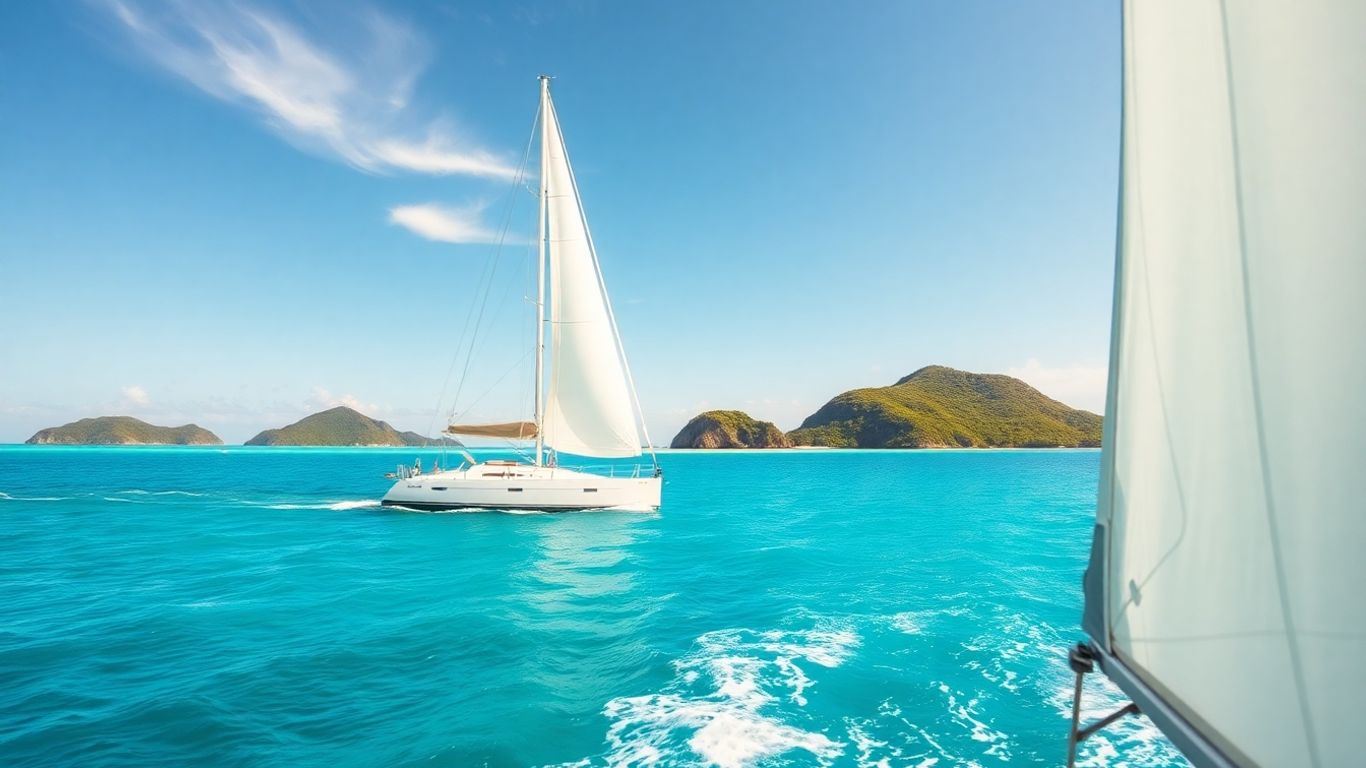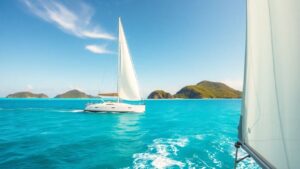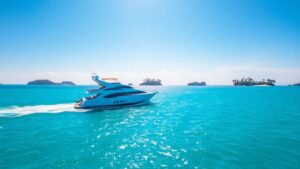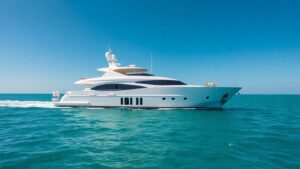Thinking about a sailing trip in the British Virgin Islands? It’s a fantastic idea! The BVI offers some of the best cruising grounds around, with calm waters and plenty of islands to explore. Whether you’re a seasoned sailor or new to the helm, a bareboat charter bvi adventure can be incredibly rewarding. We’ll walk you through the basics of planning your trip, from picking the right time to knowing what to pack. Get ready to discover why this part of the Caribbean is a favorite for so many.
Key Takeaways
- A bareboat charter bvi means you rent a yacht without a crew, making you the captain responsible for navigation and planning.
- The British Virgin Islands are ideal for beginners due to steady winds, easy navigation between islands, and many available mooring balls.
- The best times to visit for good weather and fewer crowds are typically November to June, with December to March being the busiest high season.
- When planning your bareboat charter bvi, consider the size and type of yacht that best suits your group and desired activities.
- Proper preparation, including understanding local regulations, weather patterns, and provisioning, is key to a safe and enjoyable sailing adventure.
Planning Your BVI Bareboat Charter Adventure
Getting ready for a bareboat charter in the British Virgin Islands is a bit like prepping for a big road trip, but with more water and way better views. It’s not just about showing up and sailing off; there’s some groundwork to do to make sure everything goes smoothly.
Understanding Bareboat Chartering in the BVI
So, what exactly is a bareboat charter? Basically, you’re renting a boat, like a sailboat or a catamaran, without a captain or crew. This means you and your group are in charge of everything: steering the boat, figuring out where to go, and making sure you have enough food and drinks. It’s a fantastic way to have total freedom to explore the islands at your own pace. You’ll need to show you have some sailing experience to be approved, but if you’re new to it, you can always hire a captain for part of your trip to get a feel for it.
Choosing the Right Time for Your BVI Sailing Trip
When you decide to go really matters. The BVI has good weather most of the year, thanks to those steady trade winds. But there are definitely peak and off-peak times.
- High Season (December – March): This is when most people visit. The weather is usually perfect – sunny with pleasant breezes. Expect bigger crowds and higher prices for charters.
- Shoulder Season (April – May & November): The weather is still great, but there are fewer people around. It’s a good balance if you want nice conditions without the biggest crowds.
- Low Season (June – October): This is also hurricane season, though direct hits are not that common. Some charter companies might close for a bit during the peak months (August-October). The upside? Fewer people and lower prices. Plus, the water is warmest.
The BVI are only accessible by boat, so planning your arrival and departure is key. Make sure your charter dates align with your travel plans to the islands.
Essential Paperwork for Your BVI Charter
Don’t forget the boring stuff! You’ll need a few things sorted before you can cast off.
- Passports and Visas: Make sure everyone on board has valid passports. Check if any country you might visit requires a visa.
- Sailing Resume/Experience: Most charter companies will want to see proof of your sailing experience. This could be a sailing resume detailing boats you’ve handled and courses you’ve taken.
- Charter Agreement: This is your contract with the charter company. Read it carefully!
- Cruising Permits and National Parks Licenses: You’ll need these to sail in the BVI and visit certain areas. The charter company usually helps with this, but it’s good to know they’re required.
- Insurance: Ensure you have adequate travel insurance and understand the boat’s insurance coverage.
Navigating the British Virgin Islands
Easy Navigation Between Islands
The British Virgin Islands are often called the sailing capital of the world, and for good reason. The islands are pretty close together, making it simple to hop from one spot to another. You’ve got the Sir Francis Drake Channel running right through the middle, which is like a superhighway for boats. It’s protected from the open ocean, so the water is usually pretty calm. Most of the popular spots are within a few hours’ sail of each other, so you won’t spend your whole vacation just sailing.
The distances between islands are generally short, making island hopping a breeze. For example, sailing from Tortola to Virgin Gorda is only about 8 nautical miles. You can easily plan a trip that hits several islands in a week. It’s a great place for people who are new to sailing or just want a relaxed trip. You can find some great sailing itineraries to help you plan your route.
Utilizing Mooring Balls and Anchorages
When you get to a bay or cove where you want to stop, you’ll usually find mooring balls. These are basically buoys with lines attached that you can tie your boat to. Using mooring balls is a really good idea because it helps protect the coral reefs and the seagrass underneath. Anchoring is allowed in many places too, but it’s important to check the local rules. Some areas, especially in national parks, have strict no-anchoring zones to keep the environment healthy. Always look for mooring balls first if they are available.
Here’s a quick rundown on how to use them:
- Approach Slowly: Come into the mooring area at a slow speed.
- Identify a Ball: Pick an empty mooring ball that looks sturdy.
- Use a Boathook: You’ll likely need a boathook to grab the pennant (the line attached to the buoy).
- Secure Your Boat: Tie your boat securely to the pennant, making sure it’s strong enough for your vessel.
- Check Your Set: Give a gentle tug to make sure the mooring is holding.
Remember to always check the condition of the mooring ball and its lines before relying on it. A quick visual inspection can save a lot of trouble.
Nighttime Sailing Considerations
Sailing after dark in the BVI is generally not recommended for most bareboat charterers, especially if you’re not very experienced. While the islands are relatively close, there are still hazards like unlit reefs, shallow areas, and other boats. The visibility can drop significantly, and it’s much harder to spot these things.
If you absolutely must sail at night, here are a few things to keep in mind:
- Know Your Route: Plan your passage well in advance and be familiar with the course.
- Use Navigation Lights: Make sure all your boat’s navigation lights are working correctly.
- Have a Lookout: Assign someone to be on watch, scanning the water and horizon.
- Slow Down: Reduce your speed to give yourself more time to react.
- Radar and GPS: Utilize your radar and GPS systems to their fullest.
Most people prefer to anchor or pick up a mooring ball well before sunset. This allows you to relax, enjoy dinner, and get a good night’s sleep without the added stress of sailing in the dark. It’s usually best to arrive at your destination with plenty of daylight to spare.
Discovering BVI's Island Gems

The British Virgin Islands are a treasure trove of unique spots, each with its own vibe. You really can’t go wrong with any of them, but some places just stand out. Island hopping here is the main event, and it’s all about soaking in the distinct character of each place you drop anchor.
Island Hopping Highlights
When you’re sailing around, certain islands just call to you. Virgin Gorda is famous for The Baths, a natural wonder where giant boulders create cool tidal pools and grottoes. You can wade through them, which is pretty neat. Then there’s Anegada, a flat coral island that feels totally different. It’s known for its long, empty beaches and, if you’re lucky, you might spot some flamingos. Jost Van Dyke is another must-visit, especially for its beach bars. Places like the Soggy Dollar Bar and Foxy’s are legendary for a reason – good drinks, good food, and a really relaxed atmosphere. It’s a great way to experience the local culture, and you can find some fantastic rum cocktails there.
Exploring Hidden Snorkel Havens
Beyond the popular spots, there are some really special places for snorkeling. The Caves off Norman Island are pretty cool, with coral formations that make the water glow. Nearby, The Indians are a group of small rocky outcrops that are also teeming with fish. If you’re into diving, the wreck of the RS Rhone near Salt Island is a popular choice. For a more secluded experience, try looking for spots around Peter Island or even Anegada’s reef system, though be careful with the shallow areas there. Remember to pack your mask and snorkel; you won’t want to miss what’s underwater.
Experiencing Local Flavors and Markets
No trip to the BVI is complete without trying the local food. Lobster is a big deal, especially on Anegada, where it’s often grilled beachside. You’ll also find fresh fish everywhere, cooked with island spices. If you’re in Road Town on Tortola, check out the markets, especially on weekends. You can find local crafts, hot sauces, and homemade jams. It’s a good way to pick up a souvenir that actually feels like it came from the islands. Don’t shy away from trying local dishes like conch fritters or goat water stew if you see them on a menu; they’re part of the authentic experience.
The beauty of bareboat chartering in the BVI is the freedom to explore at your own pace. You can spend a whole day at one quiet cove or hop between several islands, depending on your mood. It’s all about creating your own adventure and discovering what makes these islands so special to you. This kind of trip is perfect for those who enjoy a bit of independence and want to really connect with the cruising lifestyle. For those looking for a more serviced experience, crewed yacht options are available, offering a different kind of luxury bareboat charters offer experienced sailors freedom and lower costs compared to crewed yachts, which provide luxury service.
Maximizing Your BVI Bareboat Experience
So, you’ve got your boat, you’ve got your crew, and you’re ready to hit the water in the British Virgin Islands. But how do you make sure this trip is more than just a good time – how do you make it truly epic? It all comes down to a few smart moves before and during your charter.
Provisioning and Onboard Essentials
Getting your provisions right is key. Don’t just wing it! Think about your meals for the week. Most people find it easiest to do a big shop in Tortola before you set sail. You can get everything from fresh produce to drinks. Remember, space on a boat is limited, so pack smart. Think about non-perishables and things that don’t take up too much room. Also, don’t forget the little things that make life easier:
- Sunscreen: Reef-safe is the way to go. The sun here is no joke.
- Bug Spray: Especially for evenings ashore or in more sheltered anchorages.
- First-Aid Kit: Always good to have, just in case.
- Waterproof Bags: For phones, cameras, and anything you don’t want getting wet.
- Trash Bags: Pack it in, pack it out. Let’s keep these islands beautiful.
Planning your meals ahead of time can save you a lot of stress and money. It also means you’re less likely to run out of something important halfway through your trip.
Eco-Conscious Cruising Practices
We all love the pristine beauty of the BVI, right? Let’s do our part to keep it that way. The coral reefs are fragile, and the waters are incredibly clear. It’s our job as visitors to tread lightly.
- Use Mooring Balls: Whenever possible, tie up to a mooring buoy instead of dropping anchor. This protects the seabed and coral.
- Be Mindful of Waste: Minimize plastic use. Bring reusable water bottles and shopping bags. Dispose of trash properly – either on the boat or at designated facilities ashore.
- Respect Marine Life: Don’t touch or feed the fish or turtles. Observe them from a distance.
- Choose Reef-Safe Sunscreen: Many sunscreens contain chemicals that harm coral. Look for mineral-based options.
Enhancing Your Trip with Water Sports
Sure, sailing is the main event, but the BVI offers so much more right off the back of your boat. Most charter companies let you rent extra gear, or you might have it included.
- Snorkeling: The BVI is famous for its underwater world. Pack masks and snorkels for everyone. Some great spots include The Indians and the area around Anegada.
- Paddleboarding/Kayaking: These are fantastic for exploring calm bays, getting to shore, or just having some fun on the water. They’re quiet and let you get really close to nature.
- Fishing: If you have the right permits and gear, fishing can be a rewarding way to catch your dinner. Just be sure to check local regulations.
Think about what kind of activities your group enjoys most when choosing your boat and planning your itinerary. A little extra planning goes a long way to making your BVI adventure truly memorable.
Choosing Your Ideal BVI Yacht Charter
So, you’ve decided a bareboat charter in the British Virgin Islands is the way to go. Awesome! But before you can start dreaming about those turquoise waters, you need to pick the right boat and the right way to charter it. It’s not just about picking the prettiest boat; it’s about matching the vessel and the service to your crew and your vacation style.
Bareboat vs. Crewed Charter Options
When you’re looking at chartering in the BVI, you’ve got a few main paths you can take. It really boils down to how much you want to be hands-on with the sailing and planning.
- Bareboat Charter: This is where you rent the boat, and that’s it. You’re the captain, the navigator, and the chef. You’ll need to have some sailing experience to get approved, and you’ll be responsible for everything from plotting your course to making sure you have enough food and drinks onboard. It’s perfect if you love being in charge and have the skills to back it up.
- Skippered Charter: Think of this as a bareboat charter with a built-in expert. You still plan your own itinerary and manage your provisions, but a professional captain handles the sailing. This is a great middle ground if you want to relax more but still have a say in where you go and what you do.
- Fully Crewed Charter: This is the ultimate in relaxation. You get a private yacht with a captain, a chef, and often other crew members. They handle all the sailing, cooking, cleaning, and even suggest the best spots to visit. It’s like a floating hotel, but way more exclusive and tailored to you. This option is usually pricier but offers a truly pampered experience.
Selecting the Perfect Charter Yacht
Once you’ve decided on the type of charter, it’s time to pick your floating home. The BVI has a huge variety of boats, so think about what your group needs.
- Catamarans: These are super popular for a reason. They offer a lot of space, both on deck and below, and they’re really stable. Most people find them easier to handle in close quarters, and they usually have a shallow draft, which is handy for getting into those quiet coves. They often come with more amenities too, like generators and water makers.
- Monohulls (Sailing Yachts): If you’re a traditional sailor, you might prefer a monohull. They sail a bit differently than cats and can feel more like a classic sailboat experience. They might not have quite as much living space as a catamaran of similar length, but they can be a blast to sail.
- Powerboats/Power Catamarans: If sailing isn’t your main focus and you just want to cruise between islands quickly and comfortably, a powerboat or power catamaran might be your ticket. They’re fast and can cover a lot of ground, but you’ll be burning more fuel.
When choosing, consider:
- Size: How many people are in your group? Make sure there’s enough sleeping space and common areas for everyone to be comfortable.
- Layout: Do you want multiple cabins with private heads (bathrooms)? How important is the galley (kitchen) space?
- Amenities: Do you need air conditioning? A generator? A water maker? These can make a big difference in comfort, especially in the warmer months.
Picking the right boat is like choosing the right house for your vacation. It needs to fit your group, your budget, and the kind of trip you want to have. Don’t be afraid to ask the charter company for advice based on your group size and experience level.
Finding Real-Time Availability and Pricing
Okay, so you know what kind of boat you want and how you want to charter it. Now, where do you actually find one and see what it costs?
- Online Charter Marketplaces: There are several websites that aggregate listings from different charter companies. These are great for getting an overview of what’s available across the BVI and comparing prices. You can often filter by boat type, size, and even specific features.
- Direct Charter Company Websites: Many charter companies have their own websites where you can see their fleet and check availability directly. Sometimes booking direct can offer perks or a more personal touch.
- Charter Brokers: For a more hands-on approach, you can work with a charter broker. They have extensive knowledge of the market, can help you find the perfect boat based on your needs, and often have access to boats that might not be widely advertised. They don’t usually cost you extra, as they get paid a commission by the charter company.
When you’re looking at pricing, remember to check what’s included. Is it just the boat rental, or does it cover things like linens, dinghy, and outboard motor? Also, factor in potential extras like fuel, water, cruising permits, and any fees for mooring balls or national parks. Prices can also change based on the season, with the peak season (roughly December to March) being the most expensive.
Sailing Conditions and Best Practices

Understanding BVI Weather Patterns
The British Virgin Islands generally offer fantastic sailing weather, especially outside the official hurricane season (June through October). You’ll typically find steady easterly trade winds blowing between 10 to 20 knots, which makes for comfortable sailing. The Sir Francis Drake Channel, a major waterway, is quite sheltered, meaning you often get pleasant conditions even when the open sea might be a bit choppier. It’s always a good idea to keep an eye on the forecast, though. Things like ground swells, more common from November to April, can affect anchorages exposed to the north, making them less usable. Checking a reliable marine forecast, like one from PredictWind, is a smart move before you set off each day.
Always brief your crew on the day’s weather and any potential changes. Knowing what to expect helps everyone relax and enjoy the trip more.
Skills Needed for Bareboat Chartering
You don’t necessarily need formal certifications to charter a bareboat in the BVI, but having solid sailing skills is a must. Most charter companies will ask for a sailing resume if you don’t have certifications like ASA 101 (Basic Keelboat) and ASA 104 (Bareboat Cruising). These courses cover boat systems, anchoring, docking, and more, which are all pretty important when you’re in charge of the boat. If you’re new to sailing, consider taking a course or two before your trip. Even if you have some experience, practicing skills like docking and anchoring in calmer conditions is a good idea. Remember, the only way to truly get good at some things, like docking, is through practice.
- Basic Sail Trim: Knowing how to adjust your sails for different wind conditions.
- Anchoring: Being comfortable dropping and retrieving your anchor, especially if mooring balls are unavailable.
- Docking: Maneuvering the boat into a slip or alongside a dock.
- Boat Systems: Understanding how to manage fuel, water, and battery levels.
Safety Briefings for Your Crew
Before you even leave the dock, a thorough safety briefing for everyone on board is non-negotiable. This isn’t just about ticking a box; it’s about making sure everyone knows what to do in different situations. Cover the basics like where the life jackets are stored and how to put them on, how to use the fire extinguishers, and what to do if someone goes overboard. Also, explain the boat’s layout, including the location of safety equipment like flares and first-aid kits. Make sure everyone knows how to operate essential equipment, like the VHF radio, and who to contact in an emergency. A well-informed crew is a safer crew.
Your BVI Adventure Awaits
So, you’ve got the lowdown on planning your bareboat charter in the British Virgin Islands. It’s a pretty amazing way to see the islands, honestly. You get to set your own pace, find those quiet spots, and really soak it all in. Whether you’re a seasoned sailor or trying this for the first time, the BVIs offer something special. Just remember to plan ahead, check the weather, and most importantly, get ready for some incredible memories on the water. It’s not just a vacation; it’s a real adventure waiting to happen.
Frequently Asked Questions
What exactly is a bareboat charter?
A bareboat charter means you rent a boat without a captain or crew. You’re in charge of sailing, planning where to go, and getting your food and drinks. It’s like renting a car, but way more fun because it’s a boat!
Do I need a special license to charter a boat in the BVI?
You usually don’t need a formal sailing license, but you do need to show you have enough experience. This could mean having sailed before or even owning a boat. The charter company wants to make sure you can handle the boat safely.
When is the best time to go sailing in the British Virgin Islands?
The best time to visit is generally from November to June. The weather is usually great, with steady winds. December to March is the busiest, so if you like fewer crowds, consider April, May, June, or November.
What should I pack for a bareboat charter trip?
Pack light, breathable clothing, swimwear, sun protection (hats, sunglasses, reef-safe sunscreen), and comfortable shoes. Don’t forget motion sickness remedies if you need them, and maybe a good book for relaxing moments!
How do I get food and drinks for the boat?
You’ll need to ‘provision’ your boat, which means buying all your food and drinks before you leave. Many charter companies can help arrange this, or you can shop at local supermarkets on islands like Tortola. Think about easy-to-prepare meals and plenty of water!
What are some must-see places in the BVI?
Definitely check out The Baths on Virgin Gorda, with its giant rocks. Visit Jost Van Dyke for famous spots like the Soggy Dollar Bar. Norman Island has cool caves to explore, and Anegada is known for its amazing snorkeling and lobster!



